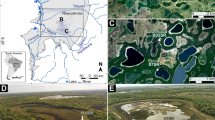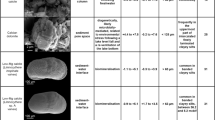Abstract
Thick Oligocene-Miocene lacustrine limestones of the Lake Mead region in southern Nevada have few adequate modern analogues that can shed light on their origin. We contend that the Lower Pahranagat Lake (LPAH), a spring-fed, alkaline lake in east-central Nevada, provides such an analogue. Through sediment cores, sampling of the lake margin, and characterization of sediment physical and chemical properties, we show that the LPAH shares a number of lithofacies in common with the Late Oligocene to Early Miocene Rainbow Gardens (RGF) and Miocene Horse Spring Formations (HSF) in the Lake Mead area. These include: stratiform stromatolites, domal stromatolites, reed beds, and intermittently laminated and massive limestones. Oxygen and carbon isotopes from authigenic carbonates support our interpretation in that the LPAH values strongly overlap those of the Oligocene-Miocene units. As a result, we interpret the Oligocene-Miocene RGF and HSF lacustrine carbonates as having been deposited in restricted, alkaline lake basins with high salinity. These basins were not conducive to the ecological success of animals and other, large multicellular organisms and, instead, fostered the growth of significant microbial communities. Lake margins, particularly during RGF deposition, were inhabited by reedy plants and salt tolerant shore grass much as is encountered in the LPAH today. These lakes were likely sourced by springs, but were nonetheless highly evaporative. Some unique aspects of both the LPAH and the Lake Mead region Oligocene-Miocene strata may shed light on the rarity of thick lacustrine carbonates in the rock record. Both of these systems are underlain by thick, Paleozoic carbonate sequences that host the principal aquifers that feed the lakes.











Similar content being viewed by others
References
Awramik SM (1992) The history and significance of stromatolites. In: Schidlowski M et al (eds) Early organic evolution: implications for mineral and energy resources. Springer, Berlin, pp 435–449
Beard LS (1996) Paleogeography of the Horse Spring Formation in relation to the Lake Mead fault system, Virgin Mountains, Nevada and Arizona; reconstructing the history of Basin and Range extension using sedimentology and stratigraphy. Geol Soc Am 303:27–60
Bertani RT, Carozzi AV (1985a) Lagoa Feia Formation (lower cretaceous), campos basin, offshore Brazil; rift valley lacustrine carbonate reservoirs; II. J Pet Geol 8:199–220
Bertani RT, Carozzi AV (1985b) Lagoa Feia Formation (lower cretaceous), campos basin, offshore Brazil; rift valley stage lacustrine carbonate reservoirs; I. J Pet Geol 8:37–58
Bohannon R (1984) Nonmarine sedimentary rocks of tertiary age in the Lake Mead region, southeastern Nevada and northwestern Arizona. U. S. Geological Survey Professional Paper, p 72
Bowen GJ, Daniels AL, Bowen BB (2008) Paleoenvironmental isotope geochemistry and paragenesis of lacustrine and palustrine carbonates, Flagstaff Formation, Central Utah, U.S.A. J Sediment Res 78:162–174
Bristow TF, Kennedy MJ, Morrison KD, Mrofka DD (2012) The influence of authigenic clay formation on the mineralogy and stable isotopic record of lacustrine carbonates. Geochim Cosmochim Acta 90:64–82
Castor SB (1993) Borates in the Muddy Mountains, Clark County, Nevada. Nevada Bureau of Mines and Geology Special Report 107
Crossey LC, Karlstrom KE, Dorsey R, Pearce J, Wan E, Beard LS, Asmerom Y, Polyak V, Crow RS, Cohen A, Bright J, Pecha ME (2015) Importance of groundwater in propagating downward integration of the 6–5 Ma Colorado River system; geochemistry of springs, travertines, and lacustrine carbonates of the Grand Canyon region over the past 12 Ma. Geosphere 11:660–682
Cyr AJ, Currie BS, Rowley DB (2005) Geochemical evaluation of Fenghuoshan Group lacustrine carbonates, north-central Tibet; implications for the paleoaltimetry of the Eocene Tibetan Plateau. J Geol 113:517–533
Dean WE (1974) Determination of carbonate and organic matter in calcareous sediments and sedimentary rocks by loss on ignition: comparison with other methods. J Sediment Pet 44:242–248
Dupraz C, Visscher PT, Baumgartner LK, Reid RP (2004) Microbe-mineral interactions: early carbonate precipitation in a hypersaline lake (Eleuthera Island, Bahamas). Sedimentology 51:745–765
Eakin TE (1966) A regional interbasin groundwater system in the White River Area, southeastern Nevada. Water Resour Res 2:251–271
Faulds JE, Wallace MA, Gonzales LA, Heizler MT (2000) Depositional environment and paleogeographic implications of the late Miocene Hualapai Limestone, northwestern Arizona and southern Nevada. In: Colorado River origin and evolution; proceedings of a symposium
Garzione CN, Dettman DL, Horton BK (2004) Carbonate oxygen isotope paleoaltimetry; evaluating the effect of diagenesis on paleoelevation estimates for the Tibetan Plateau. Palaeogeogr Palaeoclimatol Palaeoecol 212:119–140
Hazan N, Stein M, Agnon A, Marco S, Nadel D, Negendank JFW, Schwab MJ, Neev D (2005) The late quaternary limnological history of lake kinneret (sea of Galilee), Israel. Quat Res 63:60–77
Hickson T, Ness A, Lamb M (2010) Deposition, age, and isotope geochemistry of the Bitter Ridge Limestone member of the Horse Spring Formation, Bitter Ridge to Gale Hills, Lake Mead, Nevada. In: Umhoefer PJ, Lamb MA, Beard LS (eds) Miocene tectonics of the Lake Mead region, central Basin and Range. Geological Society of America Special Volume 463, pp 121–145
Jayko AS (2007) Geologic map of the Pahranagat Range 30′ × 60′ quadrangle. Linc Nye Cties Nev 1(100):000
Lamb MA, Umhoefer PJ, Anderson E, Beard LS, Hickson T, Martin KL (2005) Development of Miocene faults and basins in the Lake Mead region; a tribute to Ernie Anderson and a review of new research on basins. GSA Field Guide 6:389–418
Lamb MA, Martin KL, Hickson TA, Umhoefer PJ, Eaton L (2010) Stratigraphy and age of the lower Horse Spring Formation in the Longwell Ridges area, southern Nevada; implications for tectonic interpretations. Geol Soc Am 463:171–201
Lamb M, Beard LS, Hickson T, Umhoefer PJ, Dunbar N, Schleicher J, McIntosh W (2015) Late Oligocene-early miocene landscape evolution of the Lake Mead region during the transition from Sevier contraction to Basin and Range extension. Geol Soc Am Bull 127:899–925
Migowski C, Stein M, Prasad S, Negendank JFW, Agnon A (2006) Holocene climate variability and cultural evolution in the near east from the dead sea sedimentary record. Quat Res 66:421–431
Muniz M, Bosence D (2015) Pre-salt microbialites from the Campos Basin (offshore Brazil); image log facies, facies model and cyclicity in lacustrine carbonates. Spec Publ Geol Soc Lond 418(1):221–242
Paces JB, Wurster FC (2014) Natural uranium and strontium isotope tracers of water sources and surface water-ground water interactions in arid wetlands; Pahranagat Valley, Nevada, USA. J Hydrol 517:213–225
Pierson BK, Bauld J, Castenholz RW, D'Amelio E, Des Marais DJ, Farmer JD, Grotzinger JP, Jørgensen BB, Nelson DC, Palmisano AC, Schopf JW, Summons RE, Walter MR, Ward DM (1992) Modern mat-building microbial communities: a key to the interpretation of Proterozoic stromatolitic communities. In: Schopf JW, Klein C (eds) Proterozoic biosphere: a multidisciplinary study. Cambridge University Press, Cambridge, 1353 pp
Rodbell DT, Delman EM, Abbott MB, Desonen MT, Tapia P (2014) The heavy metal contamination of Lake Junín National Reserve, Peru: an unintended consequence of the juxtaposition of hydroelectricity and mining. GSA Today 24:4–10
Saller A, Rushton S, Buambua L, Inman K, McNeil R, Dickson J (2016) Presalt stratigraphy and depositional systems in the Kwanza Basin, offshore Angola. AAPG Bull 100(7):1135–1164
Seltzer G, Rodbell D, Burns S (2000) Isotopic evidence for late quaternary climatic change in tropical South America. Geology 28:35–38
Solari MA, Herve F, Le Roux JP, Airo A, Sial AN (2010) Paleoclimatic significance of lacustrine microbialites; a stable isotope case study of two lakes at Torres del Paine, southern Chile. Palaeogeogr Palaeoclimatol Palaeoecol 297:70–82
Talbot MR (1990) A review of the palaeohydrological interpretation of carbon and oxygen isotopic ratios in primary lacustrine carbonates Chemical Geology. Isot Geosci Sect 80:261–279
Talbot MR, Kelts K (1990) Paleolimnological signatures from carbon and oxygen isotopic ratios in carbonates from organic carbon-rich lacustrine sediments; Lacustrine basin exploration; case studies and modern analogs. AAPG Memoir 50:99–112
Valero-Garces BL, Delgado-Huertas A, Ratto N, Navas A, Edwards L (2000) Paleohydrology of Andean saline lakes from sedimentological and isotopic records, northwestern Argentina. J Paleolimnol 24:343–359
Valero-Garces B, Arenas C, Delgado-Huertas A (2001) Depositional environments of quaternary lacustrine travertines and stromatolites from high-altitude Andean lakes, northwestern Argentina. Can J Earth Sci 38:1263–1283
Verardo DJ, Froelich PN, McIntyre A (1990) Determination of organic carbon and nitrogen in marine sediments using the Carlo Erba NA-1500 Analyzer. Deep Sea Res 37:157–165
Western Regional Climate Center (2016) Comparative data for the Western States: http://www.wrcc.dri.edu/climatedata/comparative/ (accessed September 2016)
Wigand PE (1997) A late-Holocene pollen record from lower Pahranagat Lake, southern Nevada, USA; high resolution paleoclimatic records and analysis of environmental responses to climate change. In: Technical Report—Interagency Ecological Study Program for the Sacramento-San Joaquin Estuary vol 53. pp 63–77
Wurster, FC (2010) Pahranagat National Wildlife refuge hydrologic analysis report. U.S. Fish and Wildlife Service Report, 105 p
Acknowledgments
Funding for this work was provided by the National Science Foundation grant EAR-0838340 to Lamb and Hickson at the University of St. Thomas and by the University of St. Thomas Young Scholars Grant Program for Frahm. University of St. Thomas students Connor Edwards, Nick Hermann and Crystal Pomerleau, as well as many students in our field methods course, made significant contributions to data collection and analysis, both in the field and in lab. Hickson would like to thank Elizabeth Gierlowski-Kordesch for invaluable discussions about lacustrine and palustrine carbonates. Thanks to the staff at the Pahranagat National Wildlife Refuge for their help with field work logistics. We all give a hearty shout out to LacCore for all of their hard work at curating lake cores from around the world, answering our pesky questions, and providing world-class analytical services. This manuscript greatly benefitted from the comments of two anonymous reviewers and we thank them.
Author information
Authors and Affiliations
Corresponding author
Rights and permissions
About this article
Cite this article
Hickson, T.A., Theissen, K.M., Lamb, M.A. et al. Lower Pahranagat Lake: modern analogue for extensive carbonate deposition in paleolakes of the Late Oligocene to Miocene Rainbow Gardens and Horse Spring Formations. J Paleolimnol 59, 39–57 (2018). https://doi.org/10.1007/s10933-016-9923-1
Received:
Accepted:
Published:
Issue Date:
DOI: https://doi.org/10.1007/s10933-016-9923-1




